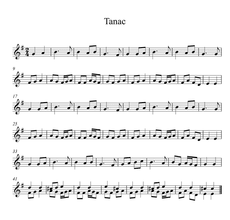TANAC
The most favored partner dance is sometimes called Po dvoje. Generally, it is danced by a man-woman couple, but if there is no man available, then by two women. The woman puts her hand on the shoulder of the man (Csárdás hold), while the man is holding the woman’s waist. There is no set formation, though according to one source from the 40s, men and women started it lining up opposite each other. However, at the end of the 19th century, it was known as a circle dance.
It has only one basic motif, which consists of two parts: the first is danced bouncing-trembling in place, the second one is a right turn with trembling steps. The first part is face-to-face, but in the second part, the dancers might shift towards each other’s side a little. In one variation, the woman may slightly be turned by her waist in the first part. And for the whole tune of the second part, a full circle might be done; we have examples of halving this (changing direction is done without a change step). It is allowed for the couples to move in the space a bit. It can be decorated with stamping, foot-swinging.
If we study the tune, it cannot be decided if a Kolo melody became independent or a Tanac one integrated into Kolo music. It must be stated that the main theme of Tanac (Išla snaša...) and one of the tunes of Kolo are nearly the same. By the name Tanac, there are several well-known tunes, which shows its popularity (Da sam ptica..., Dođi diko i nemoj..., Da mi nije ljubavi...); the similarity of the latter one to Dunje ranke is striking. Bosnyák Mária (Pupina) from Szemely used to play all of them on her harmonica, on which she performed regularly at the Sunday dances in Pogány.
The most probable supposition is that Tanac as a partner dance might have evolved from Kolo, due to the influence of other fashionable partner dances, such as Csárdás, around the middle of the 1800s. Similar dances can be found with neighboring minorities (Sokac: the tune Snašo, U tanac; Serbs of Baranya and Tolna: Mađarac, Sečujac; Serbs of Bačka: Cigančica, Po dvoje; Northern parts of Croatia: Čardas, Drmeš; Serbs from Desk: Po dvoje; Serbs around Budapest Lepa Nera). It must be noted, that different partner and circle dances exist by the same name by the Adriatic Sea (Krčki tanac, Paški tanac), in the Dinari zone (Lički tanac), and of Crna Gora origin in Serbia (Sitan tanac, Pleti tanac). This implies that the name Tanac is ancient and denotes a partner dance.
The dance’s relationship to magic is indicated by starting it with the yell Za kudilju!, so that the hemp should grow higher, as the explanation goes. Consequently, Tanac may also belong to the family of dances classified as dances performed for the sake of a better harvest (like Dučec from Posavina, Nebesko from Slavonia), which are also found in the medieval “branle” tradition (see the French “Hault Barrois” branle).
The intensified music and steps of Tanac, as well as the partner dances, always create a heightened atmosphere at a dance; we heard of an instance from the 50s from Szemely, when a lad danced it alone on a chair for a bet.
At weddings, solely Tanac was danced during the gift-giving (fiancée dance).
MUSIC
VIDEO




